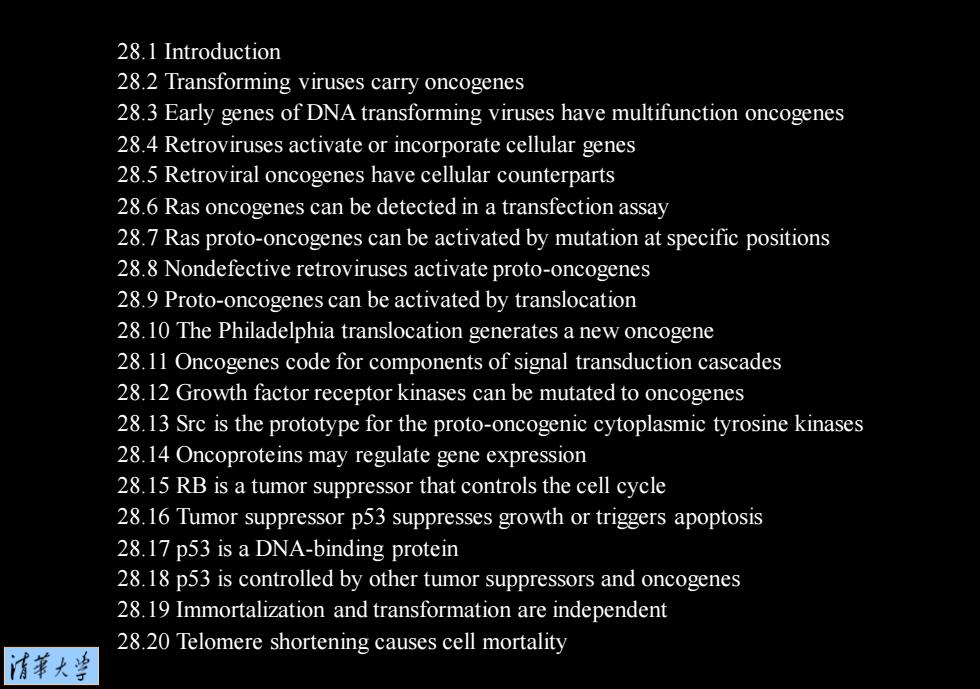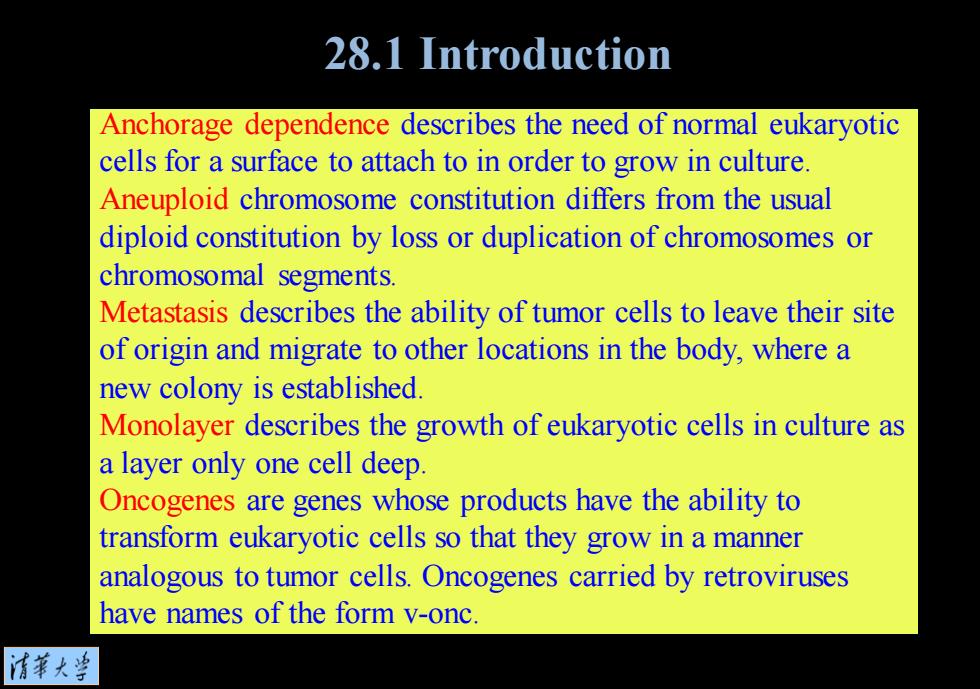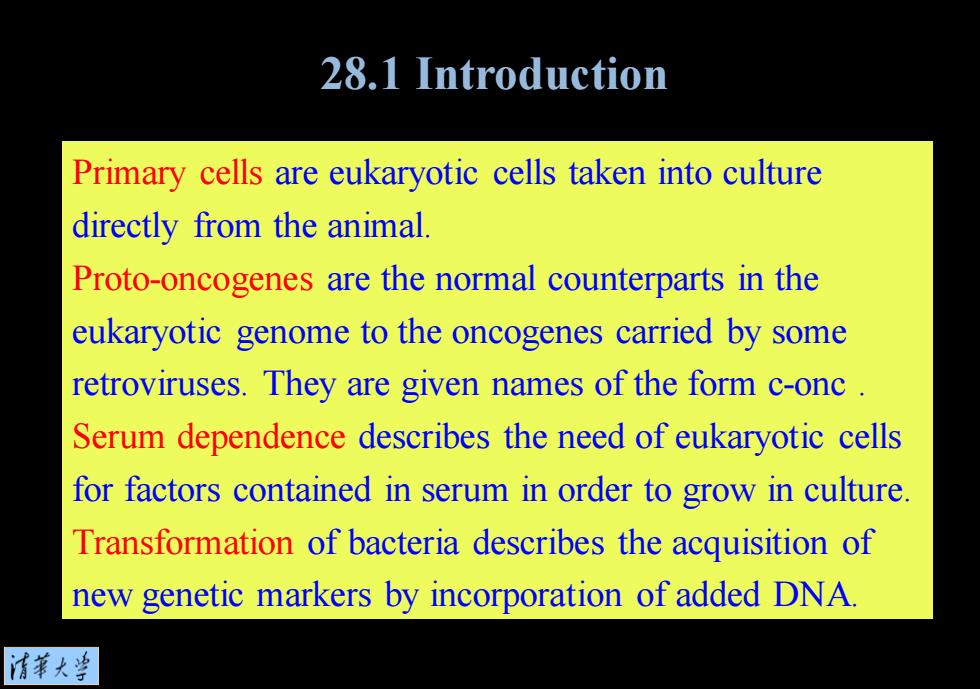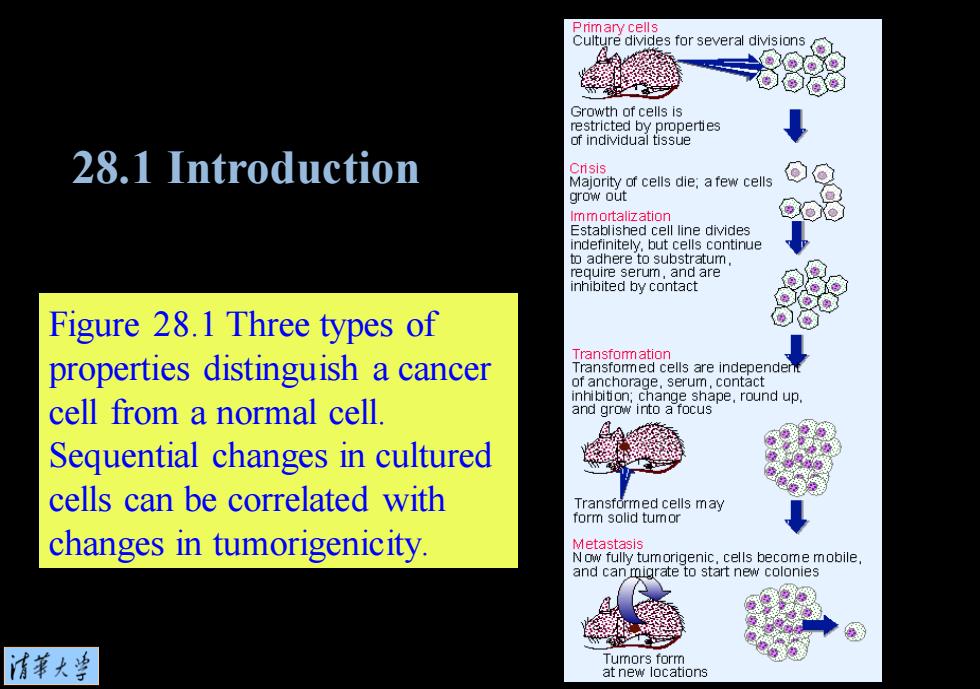
Chapter 28 Oncogenes and cancer 清第大当
Chapter 28 Oncogenes and cancer

28.1 Introduction 28.2 Transforming viruses carry oncogenes 28.3 Early genes of DNA transforming viruses have multifunction oncogenes 28.4 Retroviruses activate or incorporate cellular genes 28.5 Retroviral oncogenes have cellular counterparts 28.6 Ras oncogenes can be detected in a transfection assay 28.7 Ras proto-oncogenes can be activated by mutation at specific positions 28.8 Nondefective retroviruses activate proto-oncogenes 28.9 Proto-oncogenes can be activated by translocation 28.10 The Philadelphia translocation generates a new oncogene 28.11 Oncogenes code for components of signal transduction cascades 28.12 Growth factor receptor kinases can be mutated to oncogenes 28.13 Sre is the prototype for the proto-oncogenic cytoplasmic tyrosine kinases 28.14 Oncoproteins may regulate gene expression 28.15 RB is a tumor suppressor that controls the cell cycle 28.16 Tumor suppressor p53 suppresses growth or triggers apoptosis 28.17 p53 is a DNA-binding protein 28.18 p53 is controlled by other tumor suppressors and oncogenes 28.19 Immortalization and transformation are independent 28.20 Telomere shortening causes cell mortality 清苇大兰
28.1 Introduction 28.2 Transforming viruses carry oncogenes 28.3 Early genes of DNA transforming viruses have multifunction oncogenes 28.4 Retroviruses activate or incorporate cellular genes 28.5 Retroviral oncogenes have cellular counterparts 28.6 Ras oncogenes can be detected in a transfection assay 28.7 Ras proto-oncogenes can be activated by mutation at specific positions 28.8 Nondefective retroviruses activate proto-oncogenes 28.9 Proto-oncogenes can be activated by translocation 28.10 The Philadelphia translocation generates a new oncogene 28.11 Oncogenes code for components of signal transduction cascades 28.12 Growth factor receptor kinases can be mutated to oncogenes 28.13 Src is the prototype for the proto-oncogenic cytoplasmic tyrosine kinases 28.14 Oncoproteins may regulate gene expression 28.15 RB is a tumor suppressor that controls the cell cycle 28.16 Tumor suppressor p53 suppresses growth or triggers apoptosis 28.17 p53 is a DNA-binding protein 28.18 p53 is controlled by other tumor suppressors and oncogenes 28.19 Immortalization and transformation are independent 28.20 Telomere shortening causes cell mortality

28.1 Introduction Anchorage dependence describes the need of normal eukaryotic cells for a surface to attach to in order to grow in culture Aneuploid chromosome constitution differs from the usual diploid constitution by loss or duplication of chromosomes or chromosomal segments. Metastasis describes the ability of tumor cells to leave their site of origin and migrate to other locations in the body,where a new colony is established. Monolayer describes the growth of eukaryotic cells in culture as a layer only one cell deep. Oncogenes are genes whose products have the ability to transform eukaryotic cells so that they grow in a manner analogous to tumor cells.Oncogenes carried by retroviruses have names of the form v-onc. 情華大当
Anchorage dependence describes the need of normal eukaryotic cells for a surface to attach to in order to grow in culture. Aneuploid chromosome constitution differs from the usual diploid constitution by loss or duplication of chromosomes or chromosomal segments. Metastasis describes the ability of tumor cells to leave their site of origin and migrate to other locations in the body, where a new colony is established. Monolayer describes the growth of eukaryotic cells in culture as a layer only one cell deep. Oncogenes are genes whose products have the ability to transform eukaryotic cells so that they grow in a manner analogous to tumor cells. Oncogenes carried by retroviruses have names of the form v-onc. 28.1 Introduction

28.1 Introduction Primary cells are eukaryotic cells taken into culture directly from the animal. Proto-oncogenes are the normal counterparts in the eukaryotic genome to the oncogenes carried by some retroviruses.They are given names of the form c-onc. Serum dependence describes the need of eukaryotic cells for factors contained in serum in order to grow in culture. Transformation of bacteria describes the acquisition of new genetic markers by incorporation of added DNA. 清菜大当
Primary cells are eukaryotic cells taken into culture directly from the animal. Proto-oncogenes are the normal counterparts in the eukaryotic genome to the oncogenes carried by some retroviruses. They are given names of the form c-onc . Serum dependence describes the need of eukaryotic cells for factors contained in serum in order to grow in culture. Transformation of bacteria describes the acquisition of new genetic markers by incorporation of added DNA. 28.1 Introduction

rimary cells Culture divides for several divisions @@60 Growth of cells is restricted by properties of individual tissue 28.1 Introduction Crisis Majority of cells die;a few cells grow out Immortalization Established cell line divides indefinitely,but cells continue to adhere to substratum. require serum,and are inhibited by contact Figure 28.1 Three types of 6S8 @⊙ properties distinguish a cancer Transfom ation Transfomed cells are independent of anchorage.serum,contact nhibiti on;change shape,round up. cell from a normal cell. and grow into a focus Sequential changes in cultured cells can be correlated with Transtormed cells may form solid tumor changes in tumorigenicity. Metastasis Now fully tumorigenic,cells become mobile and can migrate to start new colonies 情菜大学 Tumors form at new locations
Figure 28.1 Three types of properties distinguish a cancer cell from a normal cell. Sequential changes in cultured cells can be correlated with changes in tumorigenicity. 28.1 Introduction